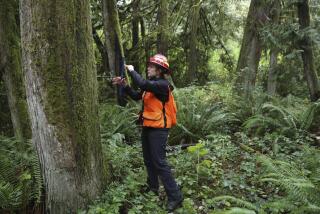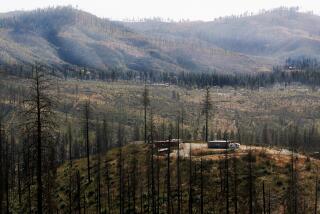Prairie’s demise linked to CO2
Rising levels of carbon dioxide in the atmosphere may be contributing to the conversion of the world’s grasslands -- crucial for livestock grazing -- into a landscape of useless woody shrubs, according to a study released today.
By artificially doubling carbon dioxide levels over enclosed sections of the Colorado prairie, researchers created a dramatic rise in Artemisia frigida, commonly known as fringed sage.
The study paints a harsh picture of what grazing lands could look like in 2100, when some project carbon dioxide levels will be double today’s.
“To the extent that CO2 is driving this conversion, this suggests the problem is going to become more intractable in the future,” said Jack Morgan, a plant physiologist at the U.S. Department of Agriculture and lead author of the study, published in the Proceedings of the National Academy of Sciences.
Scientists believe the degradation of range lands, which cover about 40% of Earth’s land surface, is mostly because of overgrazing and the modern practice of putting out fires rather than letting them burn, which destroys woody vegetation. But researchers have long suspected that rising carbon dioxide levels also play a role.
Since at least the dawn of the Industrial Revolution, when carbon dioxide levels began to rise with the burning of fossil fuels, large swaths of the world’s seasonal grasses favored by livestock have been replaced by woody shrubs.
The concentration of carbon dioxide has risen from 280 parts per million at the end of the 18th century to 385 parts per million today.
To test the effects of the greenhouse gas, scientists set up open-topped cylinders of clear plastic, 15 feet in diameter, on a prairie 40 miles northeast of Fort Collins, Colo.
They pumped pure carbon dioxide into one group of cylinders, maintaining a concentration of 720 parts per million.
The level in another group of cylinders was left at atmospheric concentrations and used as a control.
Each plot was analyzed every July, the end of the peak growing season. Then half the vegetation was removed to simulate grazing.
After five years, the researchers found a fortyfold increase in the biomass of fringed sage, from 0.72 gram per square meter in the first year to 28.7 grams per square meter in year 5. The area it covered increased from 0.2% to 4.1%.
The trend suggested that, given more time, the sage could eventually squeeze out the grasses, Morgan said.
Woody shrubs have the ability to use carbon dioxide more efficiently than many grass species and have deeper roots than grasses, enabling them to tap into deeper water supplies.
Still, some scientists said that carbon dioxide concentrations were likely to play a smaller role compared with overgrazing and fire suppression.
“The ranchers, through their own practices, have a stronger influence on the landscape than CO2 is likely to have, at least in the foreseeable future,” said Jeffrey Dukes, a biologist at the University of Massachusetts Boston, who was not involved in the study. “A herd of cows can change the landscape in the course of a week. The CO2 is working over decades.”
--







